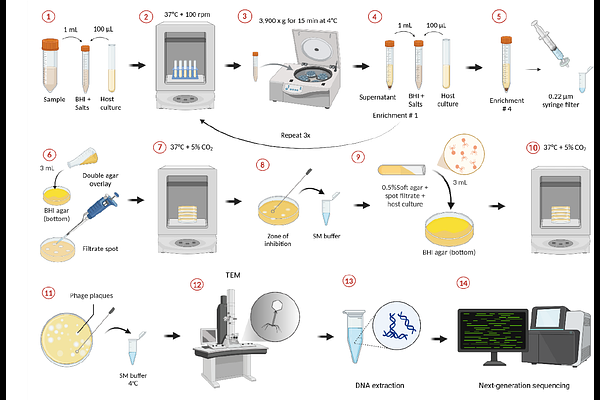Optimizing bacteriophage screening and isolation methods for microbial samples derived from different body sites of cattle

Optimizing bacteriophage screening and isolation methods for microbial samples derived from different body sites of cattle
Magossi, G.; Amat, S.
AbstractBacteriophages are gaining increased research attention as alternatives to antibiotics and microbiome manipulation tools to enhance feed efficiency and animal health in cattle. However, challenges associated with phage specificity, microbial ecosystem variations, and the absence of effective screening methods have hindered harnessing the power of phage application in cattle. The objectives of this study were to (i) optimize phage screening method for microbial samples obtained from different cattle body sites, (ii) isolate lytic phages against key bovine pathogens and commensal bacteria, and (iii) characterize the isolated phages and their bacterial hosts. A total of 1,214 samples from different cattle body sites (n = 1194) and environmental sources were screened using 13 phage detection methods, including one high-throughput approach. Eighty-three phages were isolated, primarily from ruminal fluid (59), feces (15), vaginal (7) and nasopharyngeal swabs (1), and fetal ruminal fluid (1). The bacterial hosts inhibited by these phages were from 29 genera, with Bacillus (34), Escherichia/Shigella (8), Shouchella (5), Corynebacterium (4), and Lysinibacillus (4) being the most common. No phages were identified against bovine pathogens including Trueperella pyogenes, Mannheimia haemolytica, Pasteurella multocida, or Moraxella bovis. Method 12 demonstrated the highest efficiency in phage recovery, particularly from ruminal samples. The isolation of phages against commensal bacteria from the gastrointestinal, reproductive, and respiratory tracts, and fetal gut highlights their potential for microbiome modulation to improve cattle health and feed efficiency. These findings underscore the need for further research into pathogen-targeting phage isolation in cattle.